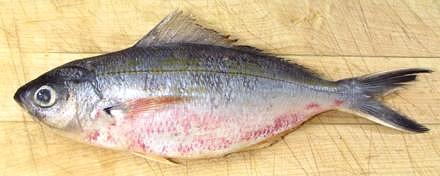 [Caesio lunaris ]
[Caesio lunaris ]
This Indo-West Pacific fish ranges from the northeast coast of Africa to the South Pacific islands, from the northern tips of Australia to the southern tip of Japan. Lunar Fusiliers can grow to nearly 16 inches, but the photo specimen, probably from Vietnam, was 9-1/2 inches and weighed 7-1/4 ounces. This fish is IUCN Red List NE (Not Evaluated) and is not endangered
This fish varies in color from silver- blue with a yellow tail to the reddish color scheme of the photo specimen, the form in which it is commonly marketed here in Los Angeles.
More on Fusiliers.
The Lunar Fusilier is a meaty fish and its flesh has an interesting medium flavor. The dark layer under the skin is small and does not have a strong taste. The flesh seems very soft when raw, but it becomes very firm with cooking.
The flesh firms up and holds together with wet cooking so it can be used in soup. Chunks may be skin-on or skin-off, but should go in not long before serving. The chunks won't fall apart, but they may get overly firm and have a dry texture, probably because this fish has so little oil.
Pan dressed fish steam well and disassembling them on the plate is quite manageable, especially if the ribs have been pulled out before cooking.
Scales: This fish is completely covered with small scales that scrape off easily with very little flying about. The only problem with scaling is that the belly is so thin and soft it may split while being scraped.
Cleaning Most of the innards seem to be up in the head and not easy to get at. The gills are very far forward and pull rather hard. For these reasons I recommend immediately removing the head unless you really want a head-on fish. The body cavity extends significantly beyond the vent, so make your cut from right in front of the anal fin forward to under the chin.
Fillet: This is an easy fish to fillet with an easy to follow bone structure. Cut down from the top to the backbone, then over the backbone at the tail until you get to the rib cage. Cut the ribs off with kitchen shears and pull them from the fillet - they pull very easily. There are a quite few significant centerline pin bones, but they are easy to locate and pull.
Yield: A 7-1/4 ounce fish yielded 4-1/4 ounces of skin-on fillet (59%) 3-7/8 ounces skin-off (53%). The skirt area is small and thin. Best, even with a whole pan dressed fish, to pull the ribs out and cut the skirt off.
Skin: The skin has no strong or "off" flavor. It has very moderate shrink, so skin-on fillets can be pan fried successfully. The fillets will thicken a bit when flipped to the skin side, but don't curl significantly. The skin still adheres well to the flesh after cooking and cannot be removed. Skinning this fish by the normal long knife and cutting board method is not difficult if the fish is large, say, 8 inches and above. The flesh of small fish may break up some when skinning, but the skinning will succeed. Fillets for poaching should be skinned so they do not curl.
Stock: The heads (well cleaned and split), bones and fins, simmered slowly for about 40 minutes make a serviceable light flavored stock with almost no oil. Let the small debris settle to the bottom, then decant and remove what oil there is using your gravy separator.
sf_fusillz 110423 - www.clovegarden.com